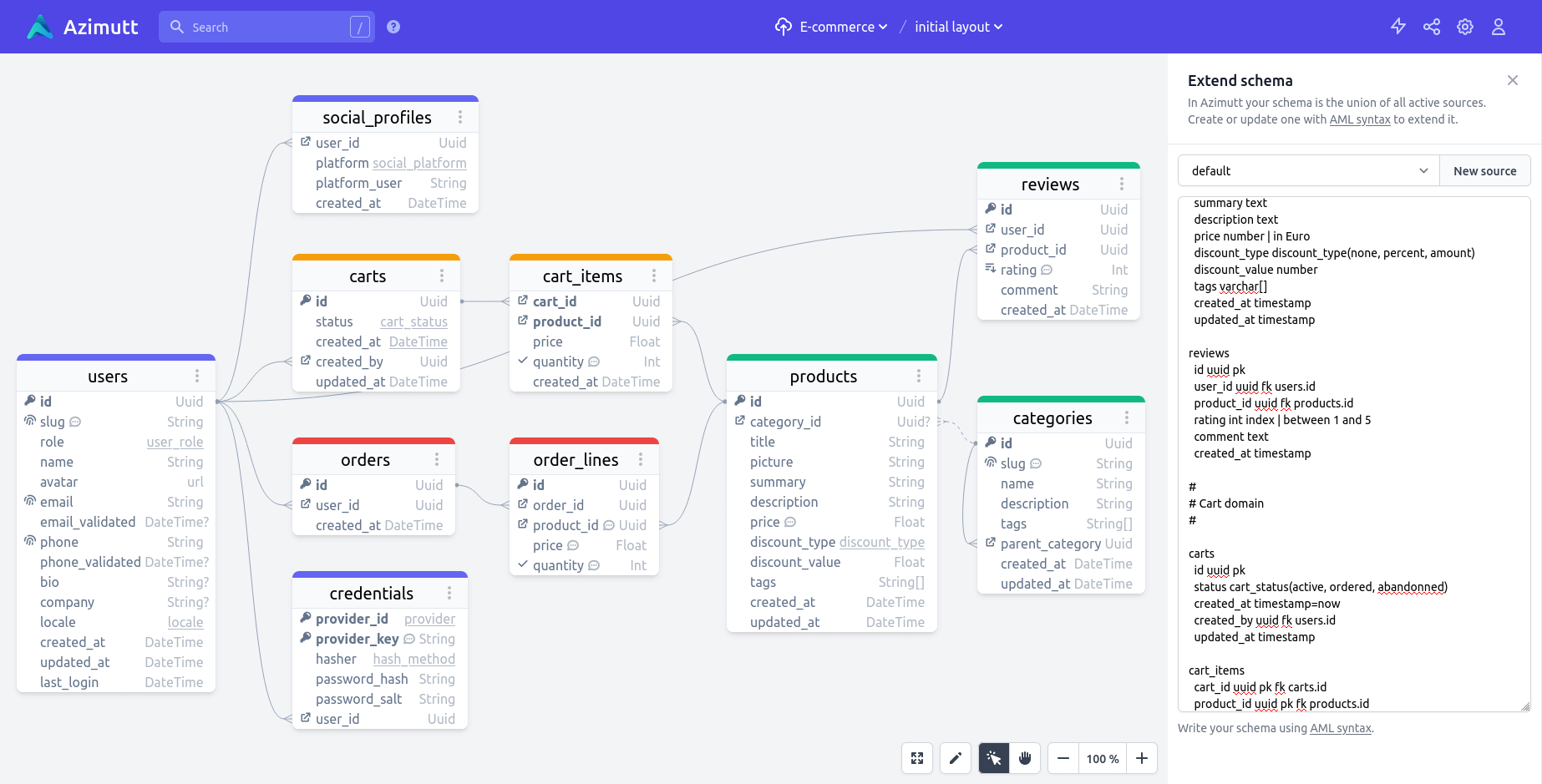
Home page • Converter • npm package
AML (Azimutt Markup Language) is the easiest language to design databases.
Made to be fast to learn and write.
Why AML? #
- Structured text is WAY better than GUI: portable, copy/paste, find/replace, versioning...
- It's simpler, faster to write and less error-prone than SQL or other database schema DSLs
- Made for humans: readable, flexible, can hold custom properties
- Database agnostic: hold concepts, not specific syntax, can be converted to other dialects
- Free as 🕊️ but also 🍺
In short, it's perfect for fast prototyping and brainstorming. And it even has its own VS Code extension!
Example #
users
id uuid pk
name varchar
email varchar index
role user_role(admin, guest)=guest
posts
id uuid pk
title varchar
content text | formatted in markdown
created_at timestamp=`now()`
created_by uuid -> users(id) # inline relation
Introduction #
This page will give you a quick overview of how to use AML, follow links for an exhaustive specification.
One last thing, AML comments are single line and start with #,
you will see them in many places 😉
Entities #
Entities can be used to model objects from databases, such as tables or collections.
Defining one in AML can't be simpler, just type its name:
posts
Entities can have attributes with several options like a type, nullability, indexes, constraints and relations.
Here is how they look:
posts
id uuid pk
slug varchar(256) unique
title varchar index
status post_status(draft, published, archived)=draft index
content text nullable
tags "varchar[]"
props json
needs_review bool
reviewed_by -> users(id)
created_by -> users(id)
created_at "timestamp with time zone"=`now()`
You can define them inside a namespace and give them an alias name for easier referencing:
core.public.users as u
id uuid pk
name varchar
core.public.posts as p
id uuid pk
title varchar
created_by -> u(id)
And you can document them both with structured properties or unstructured documentation:
events {color: red, scope: tracking, tags: [pii, deprecated]} | store all user events
id int pk {autoIncrement}
name varchar index | should be structured with `context__object__action` format
item_kind varchar {values: [users, posts, projects]} | polymorphic relation
item_id uuid
Relations #
Relations can model references, like foreign keys, or source for lineage, depending on how you want to use them.
They mostly use the -> symbol in entity definition (like used above) but can also be defined standalone with the rel keyword
and use other cardinality with -- for one-to-one
and <> for many-to-many.
users
id uuid pk
profiles
id uuid pk
user_id uuid -- users(id)
projects
id uuid pk <> users(id)
created_by -> users(id)
events
id uuid pk
created_by uuid
rel events(created_by) -> users(id)
For fastest definition, you can omit the target attribute when the target table has a primary key with a single attribute. As well as the attribute type, it will be inherited from the target attribute:
users
id uuid pk
events
id uuid pk
created_by -> users
AML supports polymorphic relations by adding the kind attribute key and value inside the relation symbol:
users
id uuid pk
projects
id uuid pk
events
id uuid pk
item_kind event_items(users, projects)
item_id
created_by -> users
rel events(item_id) -item_kind=users> users
rel events(item_id) -item_kind=projects> projects
It also supports composite relations by listing used attributes in the parenthesis:
credentials
provider_key varchar pk
provider_uid varchar pk
user_id -> users
credential_details
provider_key varchar pk
provider_uid varchar pk
provider_data json
rel credential_details(provider_key, provider_uid) -> credentials(provider_key, provider_uid)
Of course, relations can be used with nested attributes:
users
id int pk
friends "json[]"
id number -> users(id) # inline relation
events
id uuid pk
details json
user_id number
rel events(details.user_id) -> users(id) # standalone relation
Types #
You can also create custom types for better semantics, consistency or re-usability.
They can be defined inline in the entity attribute definition when not re-used, on standalone for more global usage:
type my_type # just a named type for better semantics, not really necessary in AML as types can be anything
type id_type uuid # here is a type alias
type bug_status (draft, "in progress", done) # enums are quite useful and explicit
type position {x int, y int} # even structs can be defined
type float8_range `RANGE (subtype = float8, subtype_diff = float8mi)` # custom types allows any specific definition
Full example #
Now let's write a longer AML example to see how it looks like to design your database schema with AML. This example won't use every available feature on AML but give you a good idea of the kind of code you will write using AML.
Let's define a theoretical e-commerce shop:

#
# Identity domain
#
users
id uuid pk
slug varchar unique | user identifier in urls
role user_role(customer, staff, admin)
name varchar
avatar url
email varchar unique
email_validated timestamp nullable
phone varchar unique
phone_validated timestamp nullable
bio text nullable
company varchar nullable
locale locale(en, fr)
created_at timestamp
updated_at timestamp
last_login timestamp
credentials
provider_id provider(google, facebook, twitter, email) pk
provider_key varchar pk | user id in provider system
hasher hash_method(md5, sha1, sha256)
password_hash varchar
password_salt varchar
user_id uuid -> users(id)
social_profiles
user_id uuid -> users(id)
platform social_platform(facebook, twitter, instagram, slack, github)
platform_user varchar
created_at timestamp
#
# Catalog domain
#
categories
id uuid pk
slug varchar unique | category identifier in urls
name varchar
description text
tags "varchar[]"
parent_category uuid -> categories(id)
created_at timestamp
updated_at timestamp
products
id uuid pk
category_id uuid nullable -> categories(id)
title varchar
picture varchar
summary text
description text
price number | in Euro
discount_type discount_type(none, percent, amount)
discount_value number
tags "varchar[]"
created_at timestamp
updated_at timestamp
reviews
id uuid pk
user_id uuid -> users(id)
product_id uuid -> products(id)
rating int index | between 1 and 5
comment text
created_at timestamp
#
# Cart domain
#
carts
id uuid pk
status cart_status(active, ordered, abandonned)
created_at timestamp=`now()`
created_by uuid -> users(id)
updated_at timestamp
cart_items
cart_id uuid pk -> carts(id)
product_id uuid pk -> products(id)
price number
quantity int check(`quantity > 0`) | should be > 0
created_at timestamp
#
# Order domain
#
orders
id uuid pk
user_id uuid -> users(id)
created_at timestamp
order_lines
id uuid pk
order_id uuid -> orders(id)
product_id uuid -> products(id) | used as reference and for re-order by copy data at order time as they should not change
price number | in Euro
quantity int check(`quantity > 0`) | should be > 0
If you want more examples, there is a much longer example for the e-commerce full demo, and another one with all the AML features ^^.
I hope you enjoyed AML and can only wish you happy hacking on Azimutt!
Migration from v1 #
This new version of AML is coming 2 years after the first one (post & PR ^^). During this time we discovered a lot of new use cases and some shortcomings (such as composite foreign keys).
This new iteration fixes the issues, improve consistency and add nice features such as namespace, properties, nested attributes, polymorphic relations and more.
We made it mostly retro-compatible, so you only have to fix the issued warnings in most cases. If you want to look at what needs to be adapted, look at the migration doc, or just use our converter ^^.
Other database schema DSLs #
Of course, AML is not the only DSL for database design, here are some alternatives:
- DBML
- Quick DBD syntax
- Quick SQL
- Eraser syntax
- suggest more if you know others ;)